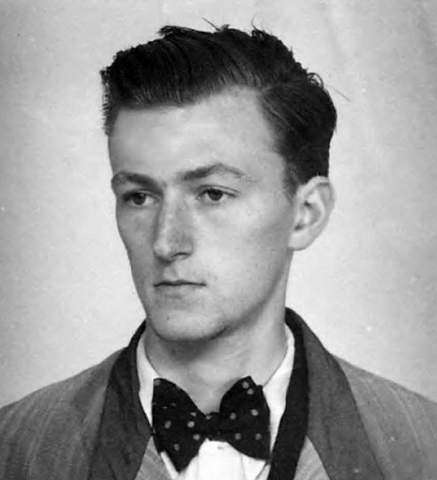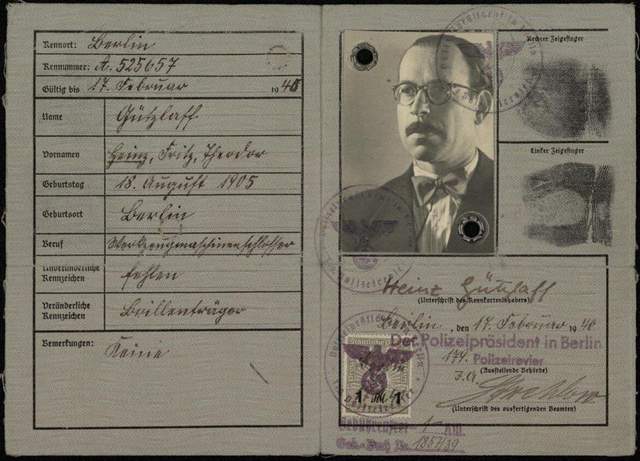A Masterpiece of a Passport Forger Schoenhaus
Masterpiece Passport Forger Schoenhaus
 It was a young passport forger who, at the end of 1942, made the “Aryan” masterpiece document in the name of Heinz Gützlaff for the Jewish doctor Kurt Hirschfeld. Cioma Schönhaus, who had once attended an arts and crafts school, knew how to do it. Was this a matter of criminal energy? On the contrary, it was a matter of removing as many people as possible who were persecuted as Jews from the crimes of a criminal regime. Masterpiece Passport Forger Schoenhaus
It was a young passport forger who, at the end of 1942, made the “Aryan” masterpiece document in the name of Heinz Gützlaff for the Jewish doctor Kurt Hirschfeld. Cioma Schönhaus, who had once attended an arts and crafts school, knew how to do it. Was this a matter of criminal energy? On the contrary, it was a matter of removing as many people as possible who were persecuted as Jews from the crimes of a criminal regime. Masterpiece Passport Forger Schoenhaus
As many as 7,000 Berlin Jews went into hiding between 1942 and 1945, it became increasingly clear that the deportations led to their deaths. One of them was Samson Schönhaus, Cioma, the only son of Russian-Jewish immigrants. In the last days of September 1942 – at just twenty years of age – he fled into illegality after his parents Fanja and Boris Schönhaus and his grandmother were deported “to the East” in June. As an armaments’ worker, Cioma had been spared deportation at that time and remained alone in Berlin.

Through a friend, he came into contact with Franz Kaufmann, a member of the Confessing Church in Berlin-Dahlem. This former government councilor of Jewish origin, who lived in a “privileged mixed marriage,” built up an entire network of helpers for Jews in hiding. He commissioned the much-needed false papers, which he then distributed to those seeking help so that they would have a chance to survive in hiding. Often believers of the Confessing Church donated their identity cards in the offertory box, which could be “reworked.” Masterpiece Passport Forger Schoenhaus
In the fall of 1942, Schönhaus delivered his “journeyman’s piece” – the first forged identification card. It had to convince Kaufmann and, above all, police officers who would control the new holder in the future. Schönhaus himself remained utterly unknown to those who came to enjoy his forgeries. Punctually and conscientiously, as if it were an ordinary job, the talented graphic artist after that delivered his products at regular intervals to Kaufmann, who enthusiastically called him “Escape King.”
Schönhaus, who preferred to work in a white coat, refined his technique more and more. Many years later, he recounted how he had gone about this challenging work: using pliers, he had to remove the eyelets with which the passport photo of the original owner was attached and carefully insert the picture of the future owner. He managed to do this with the help of an eyelet punching machine that the resourceful young man had obtained from a shoemaker. He described his increasingly professional stamps as small technical drawings. There was a tremendous demand for postcards and identification cards, especially among Jewish men, who had to reckon with controls whenever they moved in public spaces.
Schönhaus had obtained a Russian identity card for himself in the name of Peter Petrov. When he lost his wallet with this document and other papers one day, he was wanted as a “passport forger” throughout the Reich and had to go into hiding.
Helene Jacobs, also a member of the Dahlem confessional congregation and closely connected to Kaufmann’s network of helpers, became his savior. She took in the passport forger. This inconspicuous little woman – an ideal “cloak of invisibility,” as Schönhaus said in retrospect – dared risky actions to save people. In doing so, she did not shy away from “illegal” means, as she felt she was on the side of the law. Her small apartment in Wilmersdorf now became Cioma’s graphic workshop, and they both became conspiratorial friends who succeeded in contributing to the rescue of many people in hiding.
This situation ended abruptly in August 1943, when the Gestapo got on the trail of the network of helpers. Kaufmann, Helene Jacobs, and many others were arrested. Schönhaus was able to escape from Jacobs’s apartment in time after being warned, and after a few days, he fled to Stuttgart on a bicycle. He then managed to escape across the Swiss border. Franz Kaufmann was shot in Gestapo custody, Helene Jacobs was sentenced to two and a half years in prison.

About 1700 of the 7000 people in hiding in Berlin survived the period of persecution in hiding. Among them was Kurt Hirschfeld, holder of the identity card forged by Cioma Schönhaus, who was supported mainly by the resistance group “Gemeinschaft für Frieden und Auoau.” But this is another story again.
Today, the identification card can be seen at the Silent Heroes Memorial, at Rosenthaler Strasse 39 in Berlin-Mitte – incidentally not far from Sophienstrasse, where the Schönhaus family had run a mineral water company until it was confiscated in 1938 and where Cioma had grown up.
Getting together with Agnes Hirschi
FAQ Passport History
Passport collection, passport renewal, old passports for sale, vintage passport, emergency passport renewal, same day passport, passport application, pasaporte passeport паспорт 护照 パスポート جواز سفر पासपोर्ट
1. What are the earliest known examples of passports, and how have they evolved?
The word "passport" came up only in the mid 15th Century. Before that, such documents were safe conducts, recommendations or protection letters. On a practical aspect, the earliest passport I have seen was from the mid 16th Century. Read more...
2. Are there any notable historical figures or personalities whose passports are highly sought after by collectors?
Every collector is doing well to define his collection focus, and yes, there are collectors looking for Celebrity passports and travel documents of historical figures like Winston Churchill, Brothers Grimm, Johann Wolfgang von Goethe. Read more...
3. How did passport designs and security features change throughout different periods in history, and what impact did these changes have on forgery prevention?
"Passports" before the 18th Century had a pure functional character. Security features were, in the best case, a watermark and a wax seal. Forgery, back then, was not an issue like it is nowadays. Only from the 1980s on, security features became a thing. A state-of-the-art passport nowadays has dozens of security features - visible and invisible. Some are known only by the security document printer itself. Read more...
4. What are some of the rarest and most valuable historical passports that have ever been sold or auctioned?
Lou Gehrig, Victor Tsoi, Marilyn Monroe, James Joyce, and Albert Einstein when it comes to the most expensive ones. Read more...
5. How do diplomatic passports differ from regular passports, and what makes them significant to collectors?
Such documents were often held by officials in high ranks, like ambassadors, consuls or special envoys. Furthermore, these travel documents are often frequently traveled. Hence, they hold a tapestry of stamps or visas. Partly from unusual places.
6. Can you provide insights into the stories behind specific historical passports that offer unique insights into past travel and migration trends?
A passport tells the story of its bearer and these stories can be everything - surprising, sad, vivid. Isabella Bird and her travels (1831-1904) or Mary Kingsley, a fearless Lady explorer.
7. What role did passports play during significant historical events, such as wartime travel restrictions or international treaties?
During war, a passport could have been a matter of life or death. Especially, when we are looking into WWII and the Holocaust. And yes, during that time, passports and similar documents were often forged to escape and save lives. Example...
8. How has the emergence of digital passports and biometric identification impacted the world of passport collecting?
Current modern passports having now often a sparkling, flashy design. This has mainly two reasons. 1. Improved security and 2. Displaying a countries' heritage, icons, and important figures or achievements. I can fully understand that those modern documents are wanted, especially by younger collectors.
9. Are there any specialized collections of passports, such as those from a specific country, era, or distinguished individuals?
Yes, the University of Western Sidney Library has e.g. a passport collection of the former prime minister Hon Edward Gough Whitlam and his wife Margaret. They are all diplomatic passports and I had the pleasure to apprise them. I hold e.g. a collection of almost all types of the German Empire passports (only 2 types are still missing). Also, my East German passport collection is quite extensive with pretty rare passport types.
10. Where can passport collectors find reliable resources and reputable sellers to expand their collection and learn more about passport history?
A good start is eBay, Delcampe, flea markets, garage or estate sales. The more significant travel documents you probably find at the classic auction houses. Sometimes I also offer documents from my archive/collection. See offers... As you are already here, you surely found a great source on the topic 😉
Other great sources are: Scottish Passports, The Nansen passport, The secret lives of diplomatic couriers
11. Is vintage passport collecting legal? What are the regulations and considerations collectors should know when acquiring historical passports?
First, it's important to stress that each country has its own laws when it comes to passports. Collecting old vintage passports for historical or educational reasons is safe and legal, or at least tolerated. More details on the legal aspects are here...
Does this article spark your curiosity about passport collecting and the history of passports? With this valuable information, you have a good basis to start your own passport collection.
Question? Contact me...

